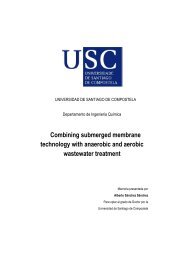Create successful ePaper yourself
Turn your PDF publications into a flip-book with our unique Google optimized e-Paper software.
9.3 PLATON - ANALYSE Menu <strong>WinGX</strong> <strong>v1.64</strong><br />
In order to run SHELXL-97 on the 'solvent-free' Fo 2 data you will need to rename the file<br />
name.HKP to name.HKL In order to get an .FCFstyle file (Fo 2 + Fc 2 (model + solvent)) you<br />
will need to run PLATON with the option<br />
CALC FCF<br />
Final R-values are reported on the basis of the WGHT parameters in the name.RES file. There<br />
will be a difference in reflection count as compared with the SHELXL-run due to the<br />
differing number of surviving 'observed' reflections. The procedure (starting from the original<br />
reflection data) can be repeated using the newly refined parameters when desired. This may<br />
define a 'refined' void area. However, there will be rarely a need to repeat the procedure. The<br />
'difference-map' improvement potential of this technique has been demonstrated for small<br />
molecule structures. The technique should also work for protein data. However, this has not<br />
been tested by us as yet with PLATON/SQUEEZE. Current design features may cause<br />
problems when tried.<br />
A directory containing test-examples is in (the PLATON ftp site at)<br />
/pub/unix/platon/TEST/SQUEEZE_TEST.'<br />
11.3 Notes on SQUEEZE<br />
• The record length of the name.HKP file has been increased above 80 to accommodate<br />
additional data (the exact details are not fixed)<br />
• The SHELXL-TWIN instruction is not available as yet in PLATON<br />
• PLATON internally calculates structure factors for the model given in the shelxl.ins file.<br />
• The solvent contribution to the structure factors is taken as 'error-free'. This means that the<br />
'solvent-free' Fo 2 keep their original su's (esd's)<br />
• The method relies heavily on the quality of the low-order reflections. The dataset should<br />
be as complete as possible. Systematic errors may hamper the quality of the results.<br />
Current conditions for applicability are<br />
1. Reasonable data-resolution (say 25 degrees Mo)<br />
2. Structure of the known part completed with H-atoms<br />
3. No more than 26 'voids' in the unit-cell<br />
4. Disorder density should be well outside the van der Waals surface of the known structure<br />
5. The area to be SQUEEZED should not be too large (say less than ~30% of the unit-cell<br />
volume.<br />
11.4 Interpretation of the results<br />
1. A successful application of SQUEEZE will show the following results:<br />
• A new hkl-file against which a satisfactory refinement of the discrete model can be done<br />
(purpose: good geometry, good R-value)<br />
• Smooth convergence of the SQUEEZE iteration.<br />
• Significant improvement of the R-value in low resolution data. (see table at the end of the<br />
listing file).<br />
• The number of electrons reported to be found in a void is close to that expected for the<br />
assumed solvent.<br />
• The difference map peaklist should not contain significant peaks outside the VOID areas.<br />
• Peaklist is given in the file name.SQZ<br />
Chapter. 9.3 PLATON 42

















